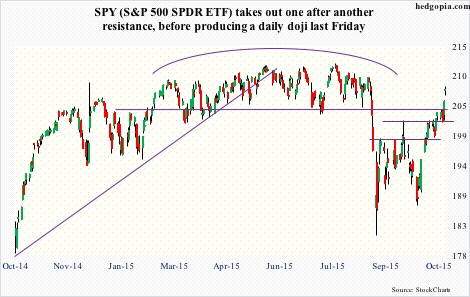Up until Wednesday last week, the hypothetical trade involving a weekly short put on SPY, the SPDR S&P 500 ETF, was going pretty well. Then came the 2.8-percent jump in the remaining two sessions, and the trade began to bleed.
To refresh, back on October 12, weekly October 16th 202.50 calls were hypothetically sold for $0.84. They got called away, resulting in an effective short at $203.34. Then a week ago, October 23rd 202 puts were sold for $0.82. If put, the short position would get covered for a profit of $2.16. Else, the short price would rise to $204.16. On Wednesday, SPY closed at $201.85. Things were headed the right way, until…
On Thursday, speaking to the press after ECB meeting, Mario Draghi, bank president, repeated what he had been saying all along. The bank is “ready to act if needed.” This time, he threw in some extra spice, saying the bank is prepared to provide additional stimulus to raise inflation to its target, probably as soon as December. Hearing possibility of more liquidity, European stocks took off, with the DAX surging 2.5 percent and the CAC 2.3 percent on Thursday. U.S. stocks tagged along, with SPY up 1.7 percent.
Come Friday, the People’s Bank of China cut its benchmark lending rate and reserve requirements for banks. The Chinese economy is losing momentum, and prices are slumping. The PBoC has responded with aggressive cuts, having eased six times since November. It is yet to have a meaningful impact on the economy. But that is not where trader focus is. Rather, markets loved the idea of more liquidity. Stocks rose again – essentially everywhere. SPY tacked on another 1.1 percent on Friday. Plus, traders reacted well to earnings from MSFT, GOOGL, and AMZN.
And quickly a trade that looked to be in the bag was in the hole.
The question for shorts now is: How best to deal with the situation?
Since the September 29th intra-day low, SPY has rallied 11 percent. The rapid rise in the price has surprised even the bulls, let alone shorts. One by one, resistance has fallen – first $198, then $202, and now $204. In the process, the ETF has taken out 50- and 200-day moving averages. The price action should be respected.
In ordinary circumstances, the best course of action would simply be to cut the losses and move on.
But this probably is not one of those times. Once again, the ETF has rallied 11 percent in 18 sessions, with central bank activism playing a big role.
If not for Mr. Draghi, would SPY be able to take out resistance at $204 on Thursday? Or for that matter, would Friday be as strong if not for the PBoC decision? Tough to say, but probably not.
On Friday, SPY produced a daily doji (as well as on the Nasdaq composite) – a sign of indecision between the bulls and bears. Also a sign of fatigue – particularly so having come after such a sharp move. Needless to say, daily conditions are grossly overbought.
For now, risk-reward dynamics probably favor staying short – not expecting SPY to fall apart but at least go test the 200-day moving average ($204.36). Assuming it does that in the coming days, that support likely gets defended.
In this scenario, another short put can help. Hypothetically, weekly October 30th $204.50 puts fetch $0.56. If SPY ($207.51) comes under pressure and is put, then the short position gets covered for a tiny profit of $0.22. Else, the premium will help push up the short price to $204.72.
Thanks for reading!
Please keep in mind that this article was originally published yesterday (October 26th) by See It Market, where I am a contributor.

